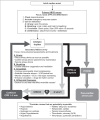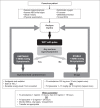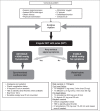Advanced Cardiac Life Support: 2016 Singapore Guidelines
- PMID: 28740999
- PMCID: PMC5523088
- DOI: 10.11622/smedj.2017064
Advanced Cardiac Life Support: 2016 Singapore Guidelines
Abstract
The main areas of emphasis in the Advanced Cardiac Life Support (ACLS) guidelines are: early recognition of cardiac arrest and call for help; good-quality chest compressions; early defibrillation when applicable; early administration of drugs; appropriate airway management ensuring normoventilation; and delivery of appropriate post-resuscitation care to enhance survival. Of note, it is important to monitor the quality of the various care procedures. The resuscitation team needs to reduce unnecessary interruptions to chest compressions in order to maintain adequate coronary perfusion pressure during the ACLS drill. In addition, the team needs to continually look out for reversible causes of the cardiac arrest.
Keywords: advanced cardiac life support; cardiac arrest; cardiac drugs; cardiopulmonary resuscitation; reversible causes.
Copyright: © Singapore Medical Association.
Figures
References
-
- Anantharaman V, Gunasegaran K. Advanced Cardiac Life Support guidelines 2011. Singapore Med J. 2011;52:548–55. quiz 556. - PubMed
-
- Harjanto S, Na MX, Hao Y, et al. PAROS study group. A before-after interventional trial of dispatcher assisted cardio-pulmonary resuscitation for out-of-hospital cardiac arrests in Singapore. Resuscitation. 2016;102:85–93. - PubMed
-
- Lai H, Choong CV, Fook-Chong S, et al. PAROS study group. Interventional strategies associated with improvements in survival for out-of-hospital cardiac arrests in Singapore over 10 years. Resuscitation. 2015;89:155–61. - PubMed
-
- Ong ME, Yan X, Lau G, et al. Out-of-hospital cardiac arrests occurring in primary health care facilities in Singapore. Resuscitation. 2007;74:38–43. - PubMed
-
- Larsen MP, Eisenberg MS, Cummins RO, Hallstrom AP. Predicting survival from out-of-hospital cardiac arrest:a graphic model. Ann Emerg Med. 1993;22:1652–8. - PubMed
Publication types
MeSH terms
LinkOut - more resources
Full Text Sources
Other Literature Sources
Miscellaneous







